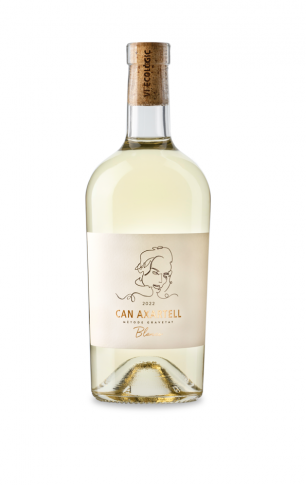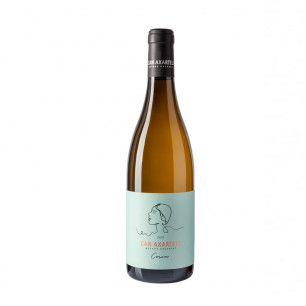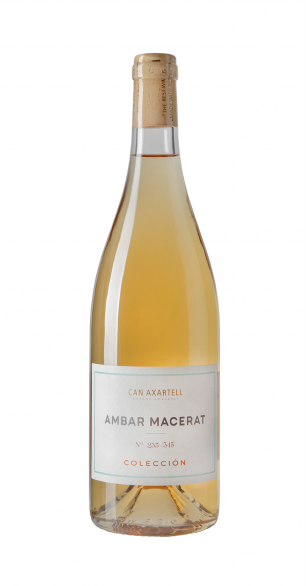Blanco
THE WINES OF CAN AXARTELL
The modern history of Can Axartell begins in the 1990s during the restoration of the centennial "possessió" (traditional Mallorcan country house), where the first vineyards were planted and cultivated under certified organic production guidelines from the getgo.
Can Axartell is an expression of tradition and modernity in Mallorcan viticulture, a reflection of the changes that have occurred over the centuries and the efforts to preserve history, cultivating local and foreign varieties and using processes such as the "Metode Gravetate".
Our modern winery was built in 2012, following the guidelines of Can Axartell:
• respect towards the grape
• environment
• the people who grow and process it
• as well as respect for people who enjoy wines.
In 2013 the first Can Axartell wines were bottled, and since then, they have built a good reputation on the island and in the world of wine.
The White wine
In Can Axartell, both Red, Rosé, and White wines are produced, as well as orange wine.
White wines are made from white grapes. The skins of the grapes are not included in the fermentation. In the winery, young white wine is produced, which goes directly after fermentation in stainless steel tanks into the bottle, and a more mature white wine is aged nine months in French oak foudres.
White wine from Can Axartell.
Our white wines are unique due to all the external factors such as the warm climate, the valley's location, the calcareous-clay soil, and most importantly, our production methods; without using any chemicals in the field or during the production process in the winery and trying to respect the product as much as possible, in an organic and as sustainable way as possible.
At Can Axartell, we have the barrel-free young white wine "Blanco," a blend of local varieties such as Malvasia, Giró Ros, and Prensal Blanc. This wine has a cheerful, light character, is fruity, fresh, and easy to drink with a good mid-palate, perfect in summer for day-to-day enjoyment. In addition, Can Axartell produces a 100% Malvasía de Banyalbufar monovarietal white wine, "Corum," matured in 2500l French oak foudres for nine months. The "Corum" is a gastronomic white wine, very aromatic characteristic of the Malvasia variety, intense and complex.
THE WINEMAKING PROCESS
The first step in the vinification process for white wines is squeezing, where the skins are broken to release part of the juices. Then the grapes are transferred to the press and go to stainless steel tanks for alcoholic fermentation to proceed with the help of yeasts. Next, the wine is transferred directly to packaging if it is a young white wine or aged in oak barrels before packaging.
Our winemaking process
At Can Axartell, the vinification process for white wines is by "Mètode Gravetat," a vinification method that is respectful of the product without the use of pumps to avoid the loss of aromas due to friction and heat. All the winemaking processes, from the grapes must and wine must fall by gravity from top to bottom without friction pumps.
The fermentation of white wines is without skins and lasts about three weeks. In the first step, the grapes fall by gravity after optical selection and crushing and are introduced into steel tanks. When these are full, a crane picks them up, and the white grapes are pressed, then the must goes down through a stainless steel tube into the stainless steel fermentation tanks. The fermentation tanks are connected directly to the bottling machine if it is a young wine or aged in French oak Foudre before bottling.
WHITE GRAPES IN CAN AXARTELL
Varieties of local white grapes
· Giró Ros: This native white grape variety would have almost become extinct if the viticulturist Joaquín Montserrat had not kept 200 vines, later multiplied by the viticulturist Toni Gelabert. It would have been a significant loss because the variety, like Pinot Gris, has pink grape skins, a delightful aroma, and more acidity than Prensal.
· Prensal blanc: The native white variety Prensal, also called Moll in Binissalem, is a very resistant variety that requires little water. For this reason, it is perfectly suitable for cultivation on the island, where water is very scarce. The grape variety is relatively neutral in aromatic terms and has very moderate acidity values. Therefore, it is a good base for Malvasía, Muscat, or Viognier.
Malvasía de Banyalbufar: The Malvasia variety is possibly a native variety of Mallorca for centuries or even millennia. The arrival of phylloxera destroyed most of the vines, and in the 20th century, this grape variety was barely cultivated. Around the year 1995, the Malvasía began to spread again slowly. At first, the vineyards are cultivated on reconstructed terraces in Banyalbufar, a town northwest of the island. The variety's acidity is high, which is usually mitigated by the late harvest, which increases sugar levels and later alcohol levels. Malvasia has often been and continues to be produced as a sweet wine with strong alcohol content. However, it is precisely in the lighter variant, with higher acidity values, that the most exciting wines are produced today.
Other white varieties
Apart from the autochthonous varieties mentioned above, internationally successful Mediterranean varieties such as Moscatel and Viognier are also planted at Can Axartell. The Muscat or Muskateller variety throughout Europe. The original Mediterranean variety is grown sweet and dry. It has a pleasant acid structure. It is known for its nutmeg, lychee, and rose aroma, accompanied by a delicate spice. On the other hand, the Viognier variety, with its aromatic, complex, and high-quality character
GEO-CLIMATOLOGICAL CHARACTERISTICS
The Can Axartell estate, located north of Mallorca in a valley south of the Tramuntana mountains, has a microclimate and a particular soil that allows us to optimally produce varieties such as Prensal, Moscatel, and Malvasía de Banyalbufar. Forty-five kilometers away, the vineyards of Finca Boscana complement those of Can Axartell. With a cooler and windier climate without the protection of the mountains and deeper soils with higher clay content, ideal for growing various varieties of white grapes, native such as Prensal, Giró Ros, and Mediterranean such as Viognier, Malvasia, Muscatel, and Garnacha Blanca. .]
Glossary
Glossary The intensity describes the The amount of color in white wines can be observed by looking at the glass at an angle of 45 degrees and the depth to which the pigment reaches. The more colorless area the wine has, it will be described as more watery and, in the case contrary, as a deep wine. Color The color scale for white wines range from lemon to brown, with lemon being the most common color within this category. When the wine has orange notes, it is described as golden, and when it has an evident level of chestnut color, it is described as amber. Nose This term is used to describe the aromas of wine, an essential element of the tasting experience that determines many of the product's quality differentiators. To evaluate it, placing your nose directly over the glass after turning it is recommended to release the aromas. Aroma intensity As a general rule, we can say that the more evident the aromas in the glass, the more pronounced the aroma is. If these are faint or inconspicuous, then the intensity of the aroma is described as light. Primary aromas A wine with a limited number of primary aromas is described as simple; when it delivers various families of primary aromas it is described as a complex wine. These come directly from the grape or the fermentation process. Secondary aromas They appear during post-fermentation processes, such as the barrel. Typical examples are vanilla, smoke, butter, and toast aromas. Tertiary aromas These originate during the aging process, either oxidative, due to the reaction with oxygen, or non-oxidative, in which the wines are protected from exposure. In both cases, the tertiary aromas are due to the modification of primary aromas in the aging process, becoming less fresh and more complex. Flavor As its name indicates, this term describes the experience of the wine on the palate. Due to the last components that define the flavors of the wine, more than one drink may be necessary for its correct evaluation. Sweetness Sweetness refers to detectable sugar levels on the tongue. It ranges from dry, a wine with no detectable levels of sugar, to too sweet, when the presence of sugar becomes a prominent attribute of the wine. Acidity The effects of acid in wine. When evaluating acidity, it is essential to remember that sugar can mask this characteristic and make a wine appear less acidic than it is. Another critical factor is the alcohol content, which can generate a similar camouflaged effect in the mouth. Tannin Mainly extracted directly from the skins of grapes during the production of red wines, tannins cause the mouth to feel dry and rough, resulting in a bitter taste. Alcohol The high alcoholic content is related to the body of the wine, and the more alcohol, it is perceived as heavy in the mouth. Typically the range is from 11% to 18%.+ Body The body describes the sensory experience through touch, directly related to its density and viscosity. Finish A term is used to describe all the sensations after tasting the wine. The intensity with which the desirable characteristics of this linger will determine whether we can name it a short or long wine.



